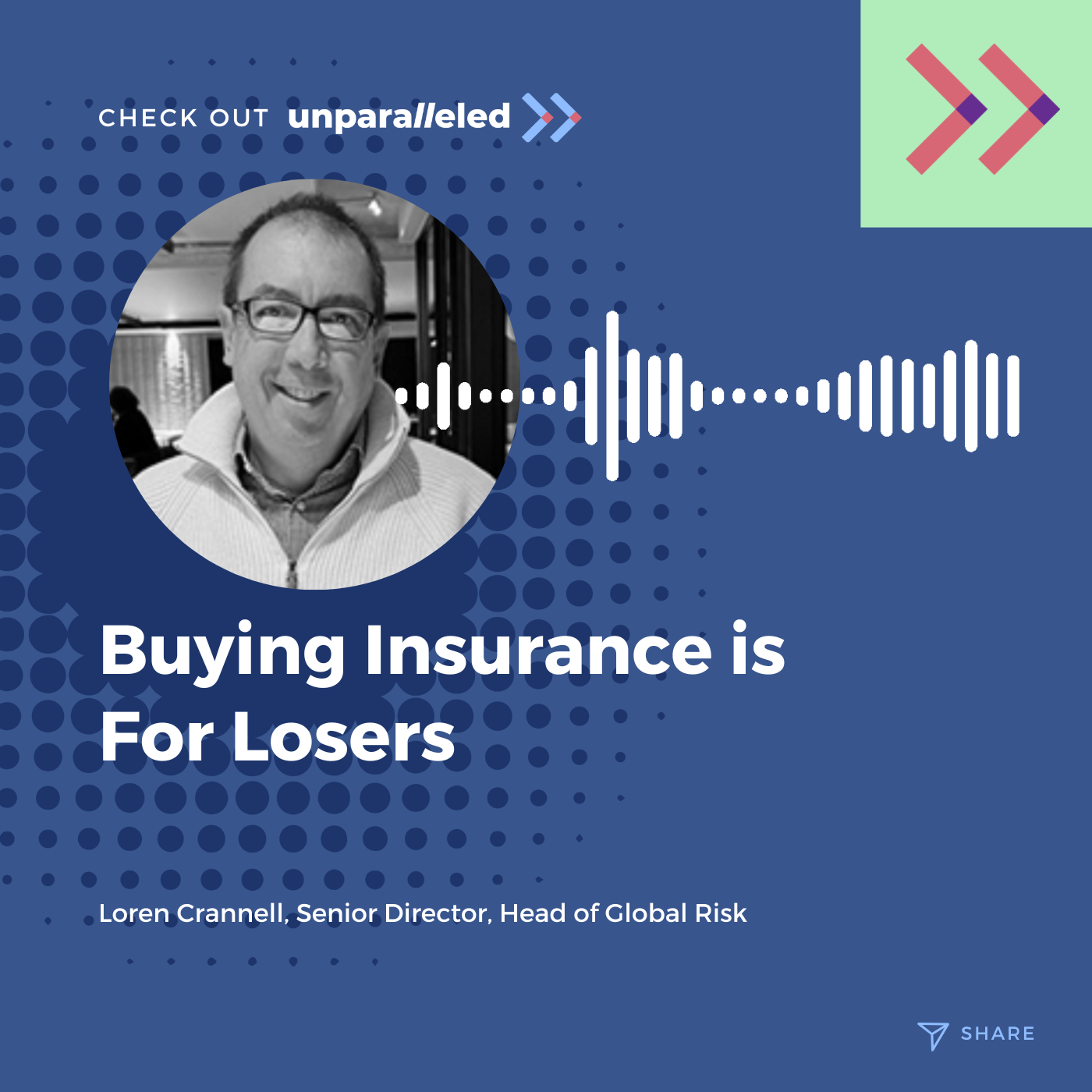podcast · Written by Guest User
Aligning Risk Management Systems with Business Success

Aligning Risk Management Systems with Business Success
Unparalleled Episode 004: Loren Crannell, Senior Director, Juul Labs
Risk management systems that embrace proactive strategies, build trust, and align risk with business objectives will continue to drive growth in the future. On today’s episode of Unparalleled, we have Loren Crannell, Director of Global Risk and Insurance at Juul, join us for a conversation about the future of risk management.
Risk Management System Redefined, Becoming a Nucleus
He shares insights into strategies that will set risk managers up for success, from how to view risk management, building trust within an organization, becoming a “nucleus,” and more.
1. Think Forward, Not Backward
From Loren’s point-of-view, risk management, as an industry, has always been rear looking. He finds this incredibly frustrating as he’s a big believer that risk management needs to be forward-thinking.
He thinks risk professionals need to be continually questioning the status quo and thinking outside of the box about what’s best for the company.
Some forward-thinking questions to ask are:
-
What are some foreseeable risks that will impact the company in the future?
-
What is the cost of those risks?
From a risk management standpoint, Loren believes that learning and utilizing captives is part of the forward-thinking approach. Captives are a more proactive approach to risk management that plays a pivotal role in risk assessment and mitigation.
Loren’s last tip for having a forward-thinking approach is that risk managers need to have confidence that what they’re doing is beneficial for their companies.
2. Pivot from Traditional Enterprise Risk Management (ERM) to Internal Consultancy
One of the best strategies Loren has utilized in his career is moving away from traditional ERM to becoming an internal consultant for his organization.
The reason Loren made this pivot is that he thinks that traditional ERM is too political and accusatory in nature. Although ERM is more widespread, Loren decided it wasn’t for him. He chose to reposition himself as an advisor and advocate for his colleagues.
The shift to being an internal consultant allowed him to focus on providing advice, reducing risks, and forging stronger relationships.
Loren feels that this new approach to risk management better aligns with who he is as a person and appreciates the grassroots aspect of it.
He can gather feedback from people in other departments to identify new solutions and help them achieve whatever it is they need to accomplish.
Because of this, people went from seeing him as a “bad guy” to a “good guy.” Now, Loren has a healthy relationship with the operational, regulatory, legal, and finance teams.
3. Build Trust to Gain Insight
Building trust and gaining insight are crucial elements of effective risk management. Loren emphasizes the importance of listening to and understanding the needs of various stakeholders.
In an organization, many people have the same goals but different ideas of how to get there. Risk managers can bridge gaps and align objectives by connecting different groups and speaking their language.
This approach fosters a culture of collaboration and ensures that risk management strategies are well-informed and relevant to the organization’s goals.
“It really takes a lot of effort to listen, reach out, and then truly find what people need help on and then actually help them.” — Loren Crannell
Juul has a Risk Advisory Group that consists of people from different departments. Through the group, Loren listens to the concerns and objectives of others in the company, which gives him more insights into what’s happening internally.
It allows him to build rapport and network with people in other departments.
Another strategy Loren uses to gain insight is to build trust with the C-suite. By having the CFO and Chief Legal Officer on his side, Loren is able to attend audit and litigation committees, which gives him valuable insights to drive the company’s risk mitigation strategies.
4. Become a Strategic Business Partner
Risk management needs to evolve and become more strategic. To evolve, risk professionals need to position themselves as strategic business partners.
They need to be more proactive when it comes to risk mitigation. Loren encourages risk professionals to integrate risk management with strategic planning.
By doing so, they can contribute directly to the organization’s growth and financial success.
“What I tell people is that you got to look cross-functionally. You have to enable the business. It’s not always about mitigating risk. It’s about accepting risk, understanding the risk, and then building business plans that make it feasible for everybody.” — Loren Crannell
Another tip for becoming a strategic business partner is to make everything quantifiable and present things in financial terms. Some questions to think about are:
-
How much money was saved in the year?
-
How many risks were mitigated?
By quantifying risks in financial terms and aligning with the C-suite’s priorities, risk management becomes a value-add function.
5. Buying Insurance is for Losers
Loren strongly believes that buying insurance is for losers. What he means by this is that risk managers need to minimize reliance on insurance and instead focus on mitigating risks through proactive measures.
“I tell people I’m not here to buy insurance. I actually want to buy less of it. People who just rely on insurance and do nothing else, they’re failing the company.” — Loren Crannell
To demonstrate his point, Loren says he would much rather spend $5 million to mitigate cyber rather than simply rely on cyber insurance policies.
As Loren pointed out, if a risk professional only focuses on buying insurance, then they’re failing their companies.
What Does the Future of Risk Management Look Like?
Risk management plays a crucial role in the success and sustainability of all organizations. It’s a dynamic field that constantly evolves to address new challenges and opportunities.
Loren hopes for a future where risk management and strategy are tightly linked. He also believes that risk professionals should find companies with products and missions that they can stand behind.
Only then can they purposefully integrate risk management into the fabric of the organization.
Risk professionals need to be proactive and forward-looking instead of being reactive. They need to be a “nucleus” that ties everything together.
By being proactive, embracing internal consultancy, building trust, and becoming strategic partners, risk managers can lead their organizations to a more resilient and prosperous future.



